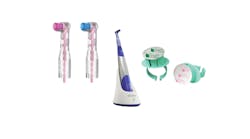I am an entrepreneur, business owner, and the only female partner at DEO—the Dentist Entrepreneur Organization. I coach dental groups on how to grow and scale in a way that keeps their teams healthy and happy. I am one of the most sought-after business coaches in dentistry. I’ve been the director of hygiene, director of operations, director of culture, and the chief operating officer for dental groups. I have an associate of applied science degree in dental hygiene. No fancy degrees, no fancy certificates; I’m a dental hygienist with some hard-won experience and an insatiable hunger for knowledge. Here, I’ll share the information I wish every dental hygienist understood regarding metrics and key performance indicators (KPIs). This knowledge will empower you to be a more informed, well-rounded, capable dental hygienist with the understanding and knowledge necessary to drive your career.
Related reading:
- Her advice for new hygienists: Find a mentor first
- 4 "green flags" to look for in a dental hygiene job
- Participating in acts of service can make you a better hygienist
Why are we so afraid?
One of the most common questions I get from clients is, “How do I get my hygienists to engage in and understand their numbers? When I bring it up, I feel like they pull out their pitchforks and torches, and I’m afraid they are going to quit.” There is some strange cultural fear among the hygiene community that knowing your performance numbers or tracking things is bad. I’m not sure where it originated or how it continues to be so pervasive, but I believe there are a few different reasons this conversation is scary:
- A fear that paying attention to numbers means we are going to be asked to overdiagnose or overtreat our patients.
- Hygienists are already experiencing a great deal of overwhelm and burnout, and this feels like it’s just a way for managers to ask us to “work harder” and place unrealistic expectations on us.
- Being accountable for something we may not understand and have never been taught feels uncomfortable. We don’t know what numbers are the most important, what they mean, and how we improve them.
I want to address each of these in this article and I hope by the end of it, readers feel less scared and more empowered.
Diagnosis and treatment
We’ve all heard the horror stories about large, corporate dental groups that overdiagnose and overtreat patients. Lawsuits, fear, dread, and people (the team and patients) being treated poorly. Is it real? Unfortunately, yes. Is it everywhere? Absolutely not. Not that I’ve seen, and I see over 300 dental groups from coast to coast.
The last thing any of us wants as a health-care provider is to feel like we have quotas to meet, that we are treating disease where no disease is present, or to be asked to do things outside of our ethics and morals. Let’s pause for a moment, take a deep breath, and break this down. Let’s separate our fears from reality and explore the idea that there is so much more to this conversation.
Perio is usually the first thing to come up in this conversation. We all feel that we do a great job of assessing and recommending periodontal treatment for our patients. Unfortunately, the data says this is an area where we struggle, as professionals. If you have “RDH” behind your name, chances are you could tell me in no time what the prevalence is of periodontal disease. “50% of adults over 30 have some form of periodontal disease, which increases to 70% over the age of 65.”1 Sound familiar? I bet you might even utilize this statistic when presenting treatment to patients. However, few of us understand or even consider how effectively we treat periodontal disease. Industry benchmarks that we have relied on for many years state that the breakdown of services for hygienists treating the general population is a mix of 60/30/10; this means 60% of your visits are likely prophies, 30% of your visits should be perio maintenance visits, and 10% should be scaling and root planing (SRP).
Dental Intelligence provides industry benchmarks based on the thousands of practices they serve nationwide. One of the metrics is the percentage of hygiene visits that are perio visits. To determine this metric, they look at the number of visits as a percentage that include codes like SRP, perio maintenance, debridement, etc. In the average practice, the percent of perio-related visits is only 18%. It should be closer to 40% if we were in-line with the prevalence of the disease and industry benchmarks. What does this mean? It means many patients are coming into the dental office and are not being assessed or treated for periodontal disease. Understanding your numbers and identifying your strengths and areas of opportunity as a clinician will enable you to be the hygienist your patients deserve.
Overwhelm and burnout
When we barely have time to eat lunch or go to the bathroom, the request to track and improve performance feels like a throat punch. But it doesn’t have to. Don’t assume that knowing and tracking your numbers means “working harder” or just cramming in more patients. Many hygienists I’ve worked with on this journey felt like understanding their numbers allowed them to be more effective; to work smarter, not “harder”; and helped them find ways to enjoy their days, save their bodies, and increase their career longevity.
After working with hundreds of clinicians, I’ve come to observe something; everyone thinks they are working as hard as they can. They believe they are as productive, effective, and efficient as possible. There is a concept called your “belief lid.” Many of us get stuck in our belief of what is possible and can’t imagine doing anything else until someone comes along and changes our perception and raises our belief lid. For example, for years, nobody thought it was possible to run a mile in under four minutes until Roger Bannister ran a 3:59 mile in 1954. Since then, it has become a standard of professional runners in several cultures, and thousands of athletes have broken the “4-minute barrier.” Roger raised the belief lid of people worldwide, and when people believed it could be done, they accomplished it.
The same is true of your work as a clinician. Until you know where you are right now and understand the levers you can pull to improve your performance, you will feel like you are running as fast as you can. I encourage you to be curious, ask questions, and approach your career and performance with a beginner’s mind. You might be amazed at how much more you can achieve.
Lack of education
Feeling nervous about being held accountable for something we don’t understand is normal. This is just a skill you haven’t learned, and it can be learned and mastered. Think back to the first time you looked at a perio chart or a full-mouth series (FMX). Do you remember immediately being able to identify key pieces of info? Did the treatment plan come naturally to you? Did you immediately pick up on the nuances of the patient’s medical history? Absolutely not! That came with practice. After hundreds of perio assessments, FMXs, and time treating patients, you’ve become an expert. The same is true here. The numbers and the names of the numbers will feel like a foreign language; it won’t make any sense. You won’t immediately know if your number is good, bad, or ugly. It takes time. I recommend educating yourself and doing some of your own tracking and observation. If you can shift your mindset and see this as a critical skill that will enable you to reach the next level of performance, I think you will come to embrace and even enjoy owning your own numbers.
In part two, I’ll break down the metrics challenge step by step.
Editor's note:This article appeared in the January/February 2023 print edition ofRDHmagazine. Dental hygienists in North America are eligible for a complimentary print subscription.Sign up here.Reference
- Gum disease by the numbers. NIH Medline Plus Magazine. January 25, 2018. https:// magazine.medlineplus.gov/article/gum-disease-by-the-numbers






